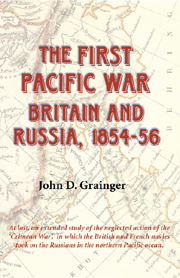Book contents
Summary
Commodore Elliot finished his report on his second expedition into the northern part of the Gulf of Tartary, in which the extent of Russian settlement on the Amur River had become much clearer, by suggesting that this would be a secure base for the development of Russian naval power. Behind the shoals and sands, but on a navigable river, ‘the extension of her naval power in the east should not be overlooked, nor can its importance be overrated’. Indeed, though he did not spell it out for lack of precise information, that naval base already existed, with a frigate (Aurora), a steamship (Vostok), and assorted smaller craft, all armed and present. If the Allies withdrew – as in fact they did, from Hakodate to Hong Kong for the winter, these Russian ships became the strongest naval force in the North Pacific, with other bases available as far east as Sitka in North America. On the other hand they could not get to sea until the ice melted in May.
Elliot added some comments on what naval force would be required for further operations. He thought in terms of either getting ships into the river, or setting up a blockade. In either case it would be steamers, of a shallow draught, which would be required. And if a blockade was imposed – he seems to have assumed that this was what would happen – there would have to be two forces, for the northern and the southern entrances to the strait.
- Type
- Chapter
- Information
- The First Pacific WarBritain and Russia, 1854–56, pp. 161 - 178Publisher: Boydell & BrewerPrint publication year: 2008



